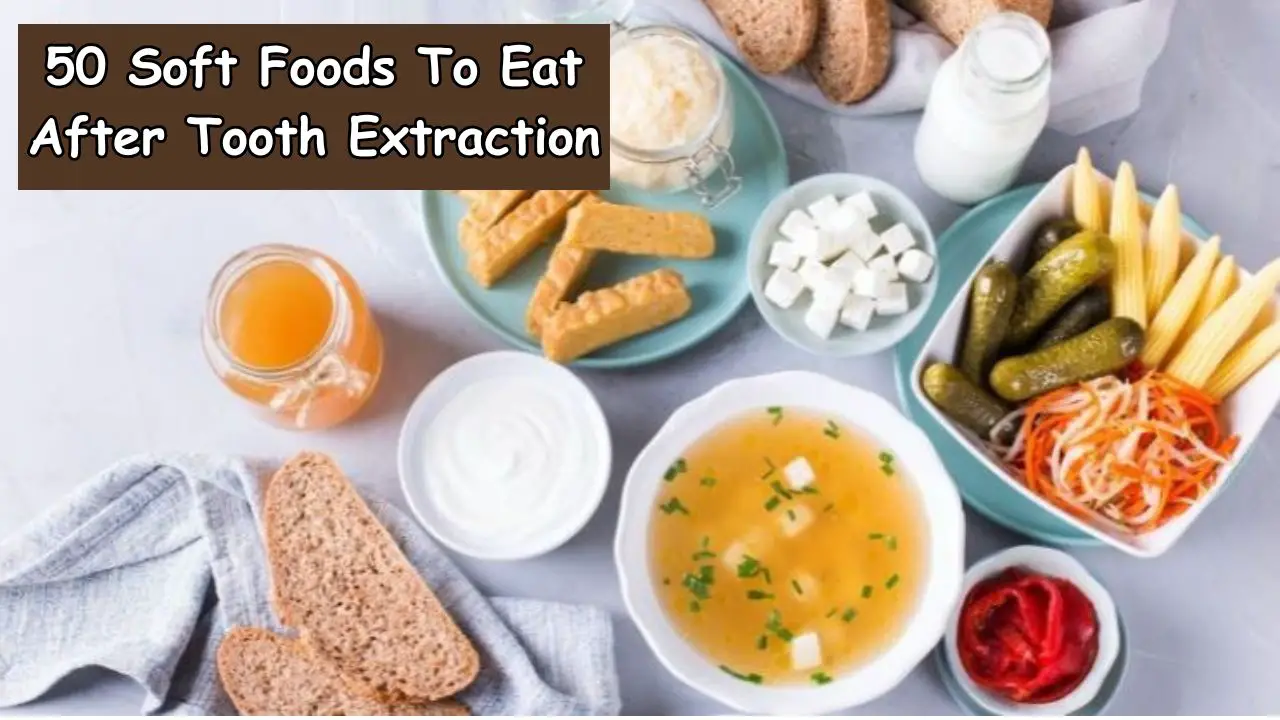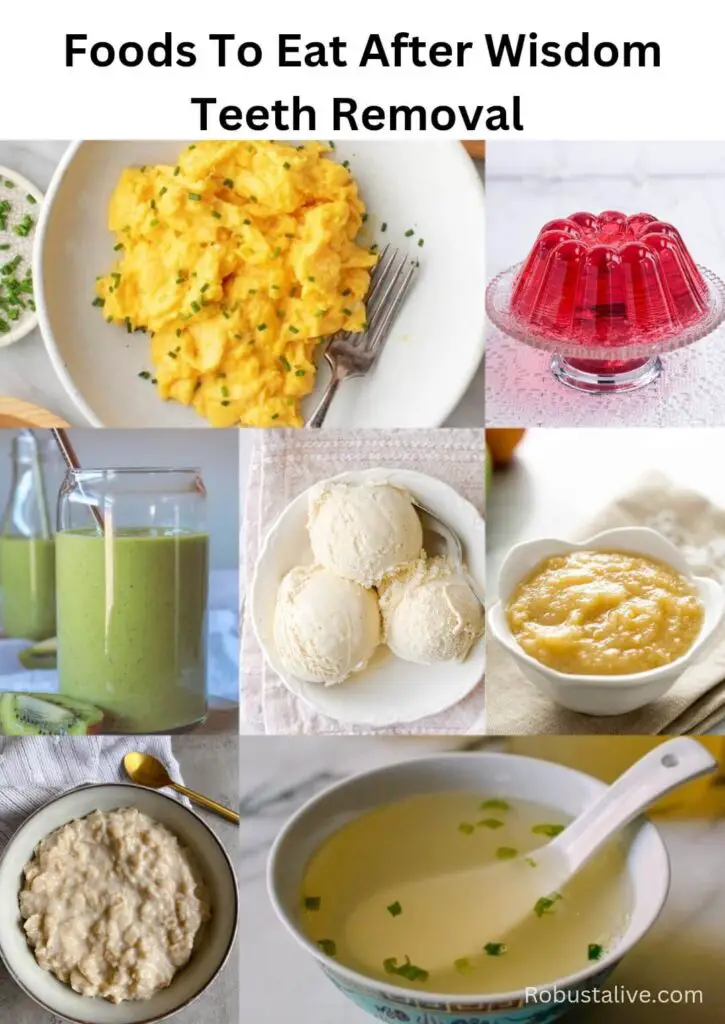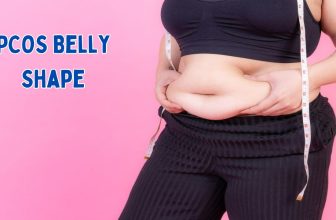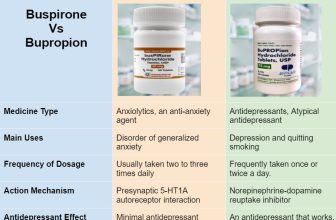50 Soft Foods To Eat After Tooth Extraction

Did you recently undergo a tooth extraction procedure and are wondering what to eat during the recovery phase?
So, what are the soft foods to eat after tooth extraction?
After tooth extraction, opt for soft, nutrient-rich foods like mashed potatoes, scrambled eggs, yogurt, smoothies, soup, ice cream, cottage cheese, oatmeal, and applesauce. These choices aid healing without irritating the surgical site.
This article will guide you through the do’s and don’ts of post-tooth extraction nutrition and provide you with a list of 50 soft foods that are perfect for a smooth and painless recovery.
Why Is Proper Nutrition Important After Tooth Extraction?
Undergoing a tooth extraction can be uncomfortable, but maintaining proper nutrition during the recovery period is essential. Your body requires nutrients to facilitate the healing and tissue repair process.
However, you can’t simply return to your regular diet right away, as the act of chewing can potentially dislodge blood clots or stitches necessary for healing.
To aid your recovery and make nutritious choices, we’ve compiled a list of 50 soft foods to eat after tooth extraction.
50 Soft Foods To Eat After Tooth Extraction
- Mashed potatoes
- Applesauce
- Yogurt (non-dairy options available)
- Oatmeal (warm oatmeal can be a filling, nutritious food)
- Smoothies (avoid seeds or chunks)
- Scrambled eggs
- Soup (broth-based)
- Jello
- Cottage cheese
- Ice cream (avoid very cold or hard varieties)
- Salmon
- Sashimi
- Cheesecake
- Creamed spinach
- Cold cereal (soaked until soft)
- Cookies (soaked in milk)
- Bread (soaked in soup)
- Custard
- Polenta
- Soft pasta
- Fish
- Greek yogurt
- Ground chicken
- Hummus
- Soft-cooked risotto
- Ricotta cheese
- Juice
- Macaroni and cheese
- Mangos
- Spinach dip
- Mashed vegetables
- Baby food
- Nut butter (e.g., peanut butter or almond butter)
- Soft seafood (Clams, Mussels, Oysters)
- Mousse
- Mashed banana
- Popsicles
- Souffle
- Pumpkin
- Mashed sweet potatoes
- Chicken noodle soup
- Guacamole
- Semolina
- Sherbet
- Biscuits (soaked or soft)
- Rice pudding
- Spaghetti
- Sweetbreads
- Tapioca
- Tea (lukewarm)
- Tofu
- Vegetables (only steamed or well-cooked)
- Waffles (can be soaked)
- Pumpkin pie filling

Foods To Eat And Avoid After Tooth Extraction
Foods To Eat
- Mashed Potatoes: They are soft and easy to swallow, providing essential nutrients for healing. Mashed potatoes are high in vitamin C, which supports recovery, and contain potassium and fiber, reducing inflammation.
- Scrambled Eggs: Eggs are rich in protein and vitamins A and B-12, which help repair cells and boost your immune system. Omega-3 enriched eggs offer additional anti-inflammatory benefits.
- Yogurt: An excellent source of protein and calcium, yogurt aids healing. Opt for plain Greek yogurt with probiotics for digestion and immune support.
- Smoothies: Customize smoothies with protein powder, nut butter, fruits, and vegetables to increase protein and nutrient content. Avoid using straws as they can dislodge blood clots.
- Soup: Nutrient-dense soups, especially those made with bone broth, provide essential proteins and minerals for healing. Load them with vegetables for added vitamins and minerals.
- Ice Cream: Cold and soothing, ice cream can reduce inflammation. Soft-serve options like banana ice cream are a good choice.
- Cottage Cheese, Oatmeal, Applesauce: These are gentle options that provide essential nutrients for healing while being easy on your mouth.
Foods To Avoid
- Solid Foods: Crunchy foods like chips, nuts, hard candy, and popcorn can dislodge blood clots, causing dry sockets and delaying healing.
- Hot Foods and Drinks: Extremely hot items can be uncomfortable and impede healing. Stick to lukewarm options until your mouth fully recovers.
- Spicy Foods: Spices like chili peppers, garlic, and ginger can cause inflammation and worsen discomfort, so avoid them until healed.
- Acidic Foods: Citrus fruits, tomatoes, and pickles are acidic and can irritate the empty tooth socket, increasing sensitivity and potentially damaging enamel.
- Chewy Foods: Avoid hard or chewy items like steak and jerky, as they can irritate the extraction area and dislodge blood clots.
- Alcoholic Beverages: Alcohol can interfere with healing and prolong recovery. Combining alcohol with pain medications or anti-inflammatory drugs can have dangerous side effects.
What Is The Best Aftercare For A Tooth Extraction?
Immediate Post-Extraction Care (Days 1-2)
After a tooth extraction, the initial 48 hours are critical for ensuring a successful healing process. Let’s delve into the specific steps for immediate post-extraction care:
- Rest and Recovery: Rest is paramount in the first 24 hours after the extraction. Avoid strenuous activities and allow your body to heal.
- Gauze Placement: The dentist will place gauze over the extraction site to control bleeding and promote the formation of a blood clot. Leave the initial gauze in place for a few hours to ensure a clot forms.
- Avoid Rinsing: It’s essential to refrain from rinsing, swishing, or gargling any liquids in your mouth during this initial phase. These actions can dislodge the developing blood clot, which is crucial for healing.
- Say No to Straws and Spitting: Using straws or spitting forcefully can create pressure in your mouth, potentially dislodging the blood clot. These actions should be avoided during the early stages of healing.
- Prevent Nasal Pressure: For extractions in the upper part of the mouth, avoid blowing your nose or sneezing forcefully, as this can create pressure in your head and dislodge the blood clot.
- No Smoking: Smoking introduces pressure in the mouth, similar to using a straw. It’s imperative to refrain from smoking during the entire healing process, but especially in the first few days when the blood clot forms.
- Pain Relief: Over-the-counter pain relievers can help reduce pain and inflammation. Follow the recommended dosage, and consult with your dentist if necessary.
- Cold Compress: Applying a cold compress for 10-20 minutes can help alleviate pain and reduce swelling. Ensure the compress is wrapped in a towel to prevent direct contact with your skin.
- Head Elevation: Elevate your head while sleeping by using extra pillows. This prevents blood from pooling in your head and aids in a faster healing.
- Follow Dentist’s Prescriptions: If your dentist prescribes specific medications, it’s essential to complete the full course of treatment as directed.
Days 3-10 – Continued Care
As you progress beyond the initial 48 hours, maintaining proper oral hygiene and a conducive environment for healing remains crucial. Here’s how to care for your mouth during this period:
- Saline Rinses: Between the third and tenth day, gently rinse your mouth with a warm saline solution or a pinch of salt in warm water. This helps kill bacteria and prevents infections as the mouth heals.
- Brush and Floss: Continue to brush and floss your teeth as usual, avoiding the extracted tooth area. The saline solution and any medicated mouthwash provided by the dentist should suffice for cleaning this area.
- Soft Foods: Stick to a soft-food diet throughout the healing process. Opt for foods that require minimal chewing and are unlikely to become trapped in the empty socket, such as soups, yogurt, and applesauce. Avoid hard, crunchy, or seedy foods.
Aftercare For Different Types Of Extractions
- Multiple Teeth Extractions: When multiple teeth are extracted simultaneously, the dentist might recommend general anesthesia. Aftercare can be challenging, and specific instructions will be provided. Clotting aids may be used to aid the healing process.
- Wisdom Teeth Extractions: Wisdom teeth extractions often require more extended recovery times. The surgery typically involves the removal of multiple teeth, and the patient may be under general anesthesia. Aftercare for wisdom teeth removal is similar to other extractions, but additional techniques, such as dissolvable stitches or clotting aids, may be employed to promote healing.
- Children’s Extractions: Children requiring tooth extractions are usually put under general anesthesia to remain unconscious throughout the procedure. Parents or caregivers must closely monitor the child’s healing and oral health. Regularly check for symptoms like pain and bleeding.
Home Remedies For Pain
It’s common to experience pain and swelling after a tooth extraction. While over-the-counter pain relievers are effective, some home remedies can help ease discomfort:
- Nonsteroidal Anti-Inflammatory Drugs (NSAIDs): Medicines like ibuprofen and naproxen can help reduce swelling and pain.
- Ice Packs: Applying a towel-wrapped ice pack to the affected area for 20-minute intervals can reduce pain and swelling.
- Saltwater Rinses: Incorporating saltwater rinses into your daily care routine can help kill bacteria, reduce swelling, and alleviate pain.
When To Seek Professional Help After Tooth Extraction?
While the normal healing process can take up to 10 days, some signs indicate the need to consult a dentist:
- Worsening Symptoms: If pain and swelling increase over time rather than improving.
- Persistent Bleeding: If bleeding doesn’t show signs of improvement.
- High Fever: A high fever is a red flag and should be addressed promptly.
- Nausea or Vomiting: If you experience nausea or vomiting that doesn’t subside, seek professional advice.
- Severe Pain Spreading To The Ear: Pain that radiates to the ear should be evaluated by a dentist.
- Foul Drainage from the Wound: If the wound begins to taste or smell foul, this may indicate an infection.
Frequently Asked Questions (FAQs)
Can I Have Cold Coffee After Tooth Extraction?
No, it’s not advisable to have cold coffee after a tooth extraction, as caffeine can still pose risks and potential discomfort during the recovery process. It’s best to stick to non-caffeinated, lukewarm, or cool beverages to promote healing.
What Kind Of Yogurt Is Good After Tooth Extraction?
Opt for Soft and smooth yogurt, such as Greek yogurt, which is best after a tooth extraction. Greek yogurt is an excellent choice because it offers a creamy texture that’s gentle on your mouth, and it’s also packed with protein and essential nutrients that can promote the healing process.
Can I drink Milk After Tooth Extraction?
It’s advisable to avoid drinking milk immediately after a tooth extraction, as dairy products can introduce bacteria to the open wound and potentially lead to infection. Dentists often recommend waiting a few days before reintroducing dairy into your diet to aid in the healing process.
In Conclusion
Proper nutrition plays a crucial role in your recovery after tooth extraction. Soft foods are your best friends during this period, ensuring that you heal quickly and comfortably. By following our list of 50 foods to eat after tooth extraction and the dos and don’ts, you will recover as smoothly as possible.
Remember, your health comes first, so choose your foods wisely during this time.






